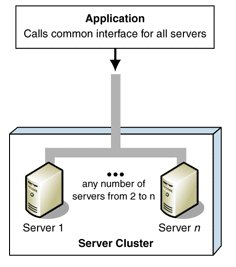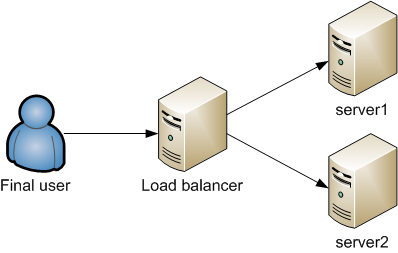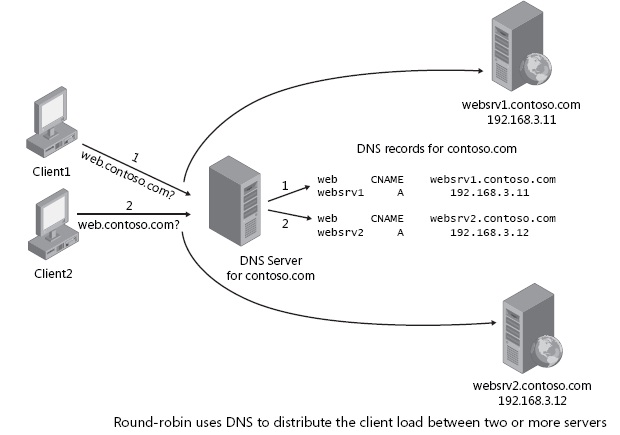A computer cluster consists of a set of loosely or tightly connected computers that work together so that, in many respects, they can be viewed as a single system. Unlike grid computers, computer clusters have each node set to perform the same task, controlled and scheduled by software.
The components of a cluster are usually connected to each other through fast local area networks ("LAN"), with each node (computer used as a server) running its own instance of an operating system. In most circumstances, all of the nodes use the same hardware and the same operating system, although in some setups (i.e. using Open Source Cluster Application Resources (OSCAR)), different operating systems can be used on each computer, and/or different hardware.
They are usually deployed to improve performance and availability over that of a single computer, while typically being much more cost-effective than single computers of comparable speed or availability.
Computer clusters emerged as a result of convergence of a number of computing trends including the availability of low-cost microprocessors, high speed networks, and software for high-performance distributed computing.[citation needed] They have a wide range of applicability and deployment, ranging from small business clusters with a handful of nodes to some of the fastest supercomputers in the world such as IBM's Sequoia. The applications that can be done however, are nonetheless limited, since the software needs to be purpose-built per task. It is hence not possible to use computer clusters for casual computing tasks.
The desire to get more computing power and better reliability by orchestrating a number of low-cost commercial off-the-shelf computers has given rise to a variety of architectures and configurations.
The computer clustering approach usually (but not always) connects a number of readily available computing nodes (e.g. personal computers used as servers) via a fast local area network. The activities of the computing nodes are orchestrated by "clustering middleware", a software layer that sits atop the nodes and allows the users to treat the cluster as by and large one cohesive computing unit, e.g. via a single system image concept.
Computer clustering relies on a centralized management approach which makes the nodes available as orchestrated shared servers. It is distinct from other approaches such as peer to peer or grid computing which also use many nodes, but with a far more distributed nature.
A computer cluster may be a simple two-node system which just connects two personal computers, or may be a very fast supercomputer. A basic approach to building a cluster is that of a Beowulf cluster which may be built with a few personal computers to produce a cost-effective alternative to traditional high performance computing. An early project that showed the viability of the concept was the 133-node Stone Soupercomputer. The developers used Linux, the Parallel Virtual Machine toolkit and the Message Passing Interface library to achieve high performance at a relatively low cost.
Although a cluster may consist of just a few personal computers connected by a simple network, the cluster architecture may also be used to achieve very high levels of performance. The TOP500 organization's semiannual list of the 500 fastest supercomputers often includes many clusters, e.g. the world's fastest machine in 2011 was the K computer which has a distributed memory, cluster architecture.

In computing, load balancing distributes workloads across multiple computing resources, such as computers, a computer cluster, network links, central processing units or disk drives. Load balancing aims to optimize resource use, maximize throughput, minimize response time, and avoid overload of any single resource. Using multiple components with load balancing instead of a single component may increase reliability and availability through redundancy. Load balancing usually involves dedicated software or hardware, such as a multilayer switch or a Domain Name System server process.
Load balancing differs from channel bonding in that load balancing divides traffic between network interfaces on a network socket (OSI model layer 4) basis, while channel bonding implies a division of traffic between physical interfaces at a lower level, either per packet (OSI model Layer 3) or on a data link (OSI model Layer 2) basis with a protocol like shortest path bridging.

An alternate method of load balancing, which does not necessarily require a dedicated software or hardware node, is called round robin DNS. In this technique, multiple IP addresses are associated with a single domain name; clients are expected to choose which server to connect to. Unlike the use of a dedicated load balancer, this technique exposes to clients the existence of multiple backend servers. The technique has other advantages and disadvantages, depending on the degree of control over the DNS server and the granularity of load balancing desired.
Another more effective technique for load-balancing using DNS is to delegate www.example.org as a sub-domain whose zone is served by each of the same servers that are serving the web site. This technique works particularly well where individual servers are spread geographically on the Internet.
